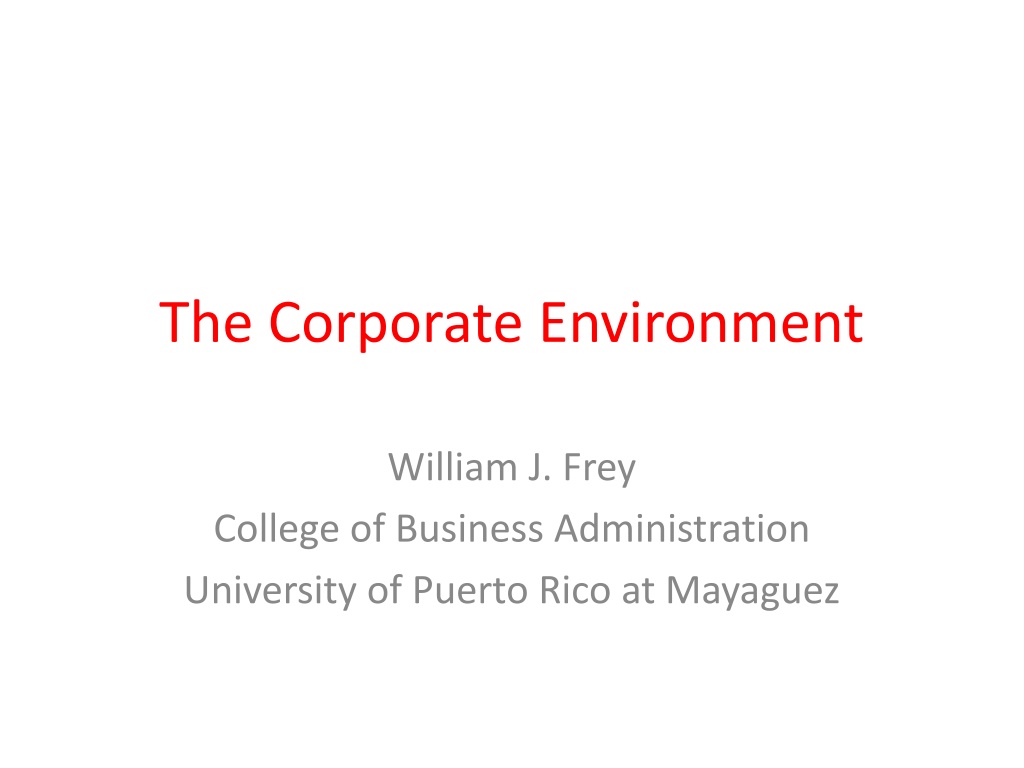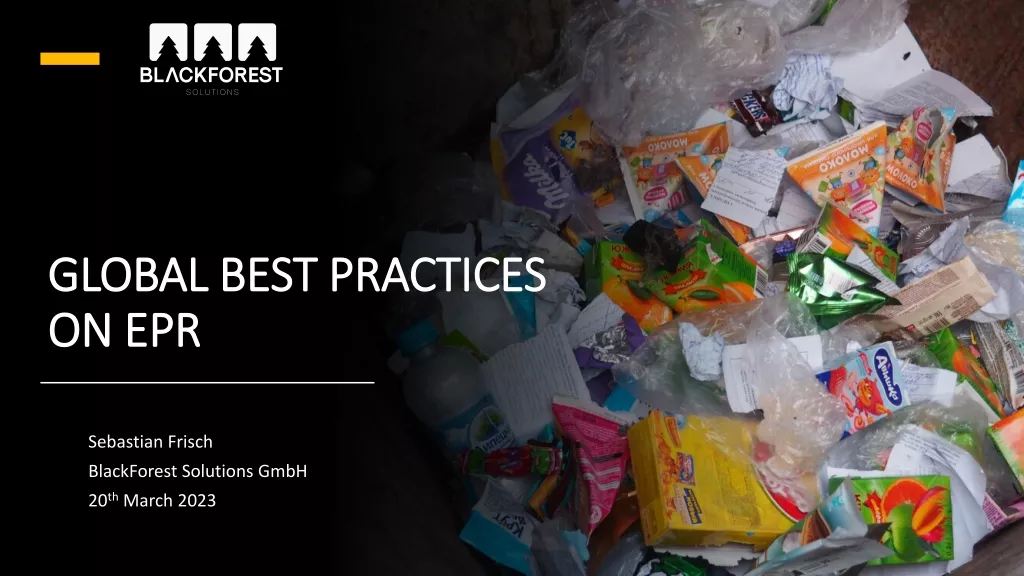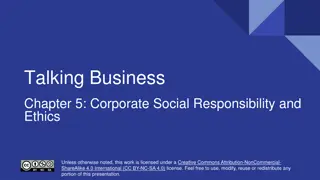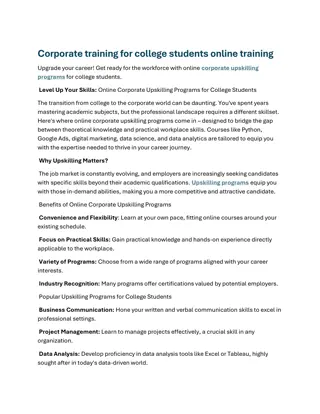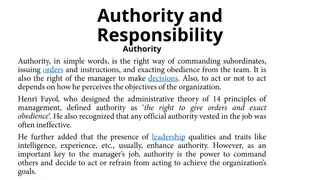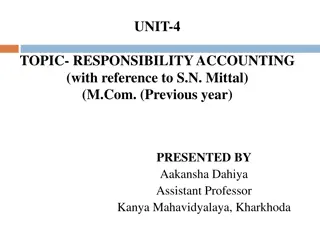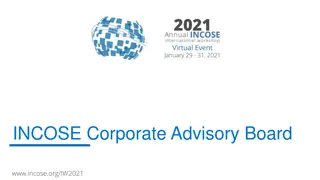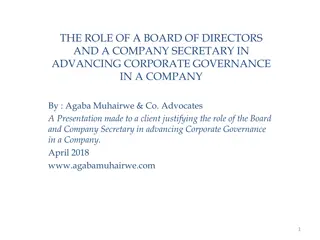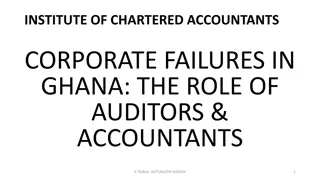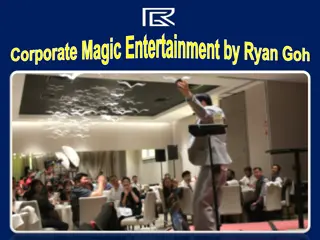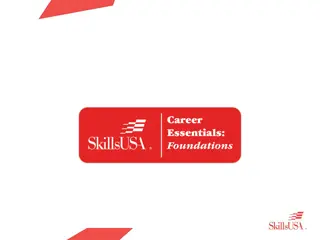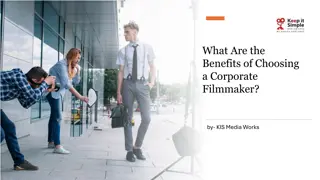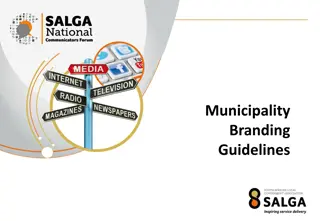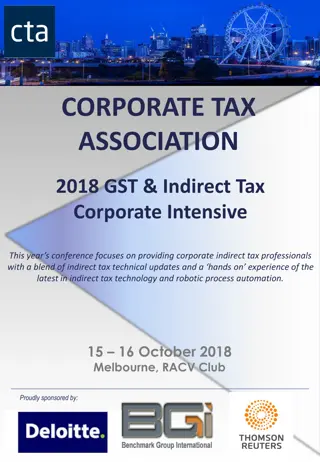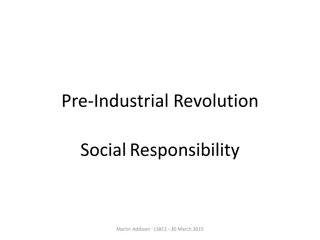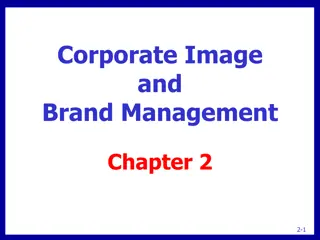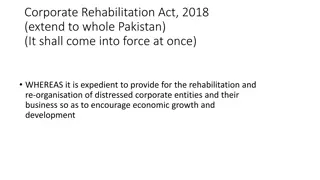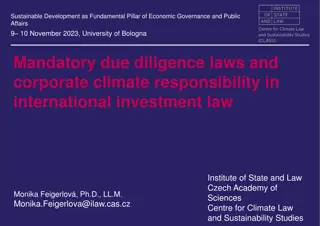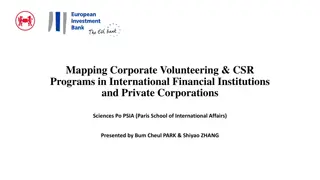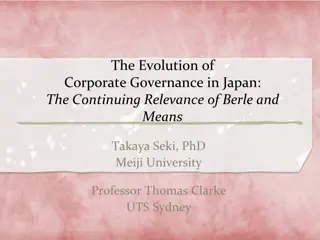Corporate Environment and Responsibility
Dive into the dynamics of corporate environments, exploring topics such as corporate responsibility, internal decision structures, cooperation, competition, and organizational constraints. Unravel the history of corporations through terms like ultra vires, implied powers, and joint stock companies. Discover the evolution of investor protection with concepts like the corporate shield. This comprehensive guide offers insights into the complex world of corporate behavior and governance.
Download Presentation

Please find below an Image/Link to download the presentation.
The content on the website is provided AS IS for your information and personal use only. It may not be sold, licensed, or shared on other websites without obtaining consent from the author.If you encounter any issues during the download, it is possible that the publisher has removed the file from their server.
You are allowed to download the files provided on this website for personal or commercial use, subject to the condition that they are used lawfully. All files are the property of their respective owners.
The content on the website is provided AS IS for your information and personal use only. It may not be sold, licensed, or shared on other websites without obtaining consent from the author.
E N D
Presentation Transcript
The Corporate Environment William J. Frey College of Business Administration University of Puerto Rico at Mayaguez
Some sources Stone, C. D. (1975) Where the Law Ends: The Social Control of Corporate Behavior. Prospect Heights, IL: Waveland Press, INC: 1-30. (History of Corporation) French, P.A. (1984) Collective and Corporate Responsibility. New York: Columbia University Press. (Corporate Responsibility based on CIDS) Fisse, B. and French, P.A., eds. (1985) Corrigible Corporations and Unruly Law. San Antonio, TX: Trinity University Press. (Corporate Punishment) P.T. Leeson. (2009). The Invisible Hook: The Hidden Economics of Pirates. Princeton: Princeton University Press: 44-81. (Pirate Articles of Agreement) Ritz, Dean. (2007) "Can Corporate Personhood Be Socially Responsible?" in eds. May, S., Cheney, G., and Roper, J., Oxford, UK: Oxford University Press: 194-195.
Tentative Schedule October and November 28 Introduce Corporate responsibility 30 Groups prepare for town meeting 1 Burger Man town meeting November 4 Debrief Burger Man and Pirate-Corporate Analogy (Corporate Internal Decision Structures) 6 Prisoner s Dilemma (Cooperation versus Competition) 8 Milgram and Zimbardo (How organizational environments constrain human action and identity) 13 Review for Exam 15 Third Exam (Codes and Organizations) 20 Hughes Case 22 Group Preparation for Dramatic Rehearsals 25 Dramatic Rehearsals (Acting, Storyboards, Reflections) 27 Responsible Dissent (Exit, Voice, Loyalty) December 2 Class Evaluations/Group Self Evaluations/Hughes Storyboard & Reflections 4 Class Evaluations/Group Self-Evaluations/Hughes Reflections & Reflections
Terms from History of Corporation Property Des Jardins (a business ethicist) characterizes property, not as a single right, but as a bundle of associated rights. These include the right to possess, control, use, benefit from, dispose of, and exclude others from one s property Ultra Vires Literally beyond the power . If a corporate charter designates something as ultra vires in relation to the corporation, it literally means that this action goes beyond the legitimate powers of the corporation. Implied Powers If a company knows of an activity (or should know of it) and still permits the activity to continue, then its consent is implied and the power to perform the action implied. Joint stock company 17thand 18thcenturies in Great Britain. Companies were formed to carry out complex business activities. Investors put their money into the venture and managers oversaw the activities. Joint Stock Companies produced problems because of unlimited liability Corporate shield The corporate shield protects investors by distributing financial risk. Investor liability limited to amount of investment.
Agency and Charters Law of Agency Responsibility of agents to remain faithful to the interests of principals Principal Originate action and determine its goal. Delegate executive authority to agent if unable to execute action working alone Agent Carries out or completes action originated by another. Responsible to principal to remain faithful to the principal s goals and interests Corporate Charter Founding document of corporation Originally the charter was a device of corporate control because it outlined what the corporation could and could not do. If not permitted by charter it was ultra vires (=beyond the power). Charter Mongering Charters allow incorporation for all legal activities. Charter no longer defines boundaries for legitimate and illegitimate corporate activities
Corporate legal and moral responsibility Corporation Internal Decision Structure or CIDS Corporate goals, decision recognition rules, roles, and organizational flow chart Licenses re-describing individual actions as corporate actions. Corporate Responsibility Holding corporations legally and morally responsible for actions performed in their name. Creates philosophical problems concerning the meaning of personhood and agency. Legal Person Created in and through the law. A legal person has legal standing: it can sue and be sued. Legal persons also have legal rights and duties. Natural Person Primarily human beings. Natural persons act through the medium of their bodies. Natural persons also have minds which form intentions (goals, purposes). Criminal law applies to natural persons who have minds (that form intentions), bodies (that act to realize intentions) and a connection between the two such that minds direct the activities of bodies. Principle of Responsive Adjustment Moral agents have an obligation to adjust their actions and habits to respond to lessons learned from the past. Stock Dilution A corporate punishment (a fine) that goes beyond the deterrence trap by tapping into the future earnings of a corporation. The stock of a company is divided (or diluted) and the additional shares are distributed to the victims of corporate wrongdoing or to the state. These shares are, then, liquidated at some future date.
1. Proto-Corporation is a Passive Device to hold property A monastery is not just the private property of the abbot The Church emerges as an abstract legal entity that holds property No problem of succession when abbot dies; abbot doesn t own it the Church does What s the Church? Something that owns property Passive: it doesn t do anything but own property
2. Proto Corporations called Trade Guilds self-regulate the practice of a trade Proto Corporations created called Trade Guilds to self- regulate the practice of a trade Example: Shoe Makers A skilled craft or trade Learn through apprenticeship Self-regulation Purpose: to regulate a practice or trade. Why ? Members make more money guild becomes monopoly (controls who can practice) and dictates prices for services More social responsibility exercised: sets standards and punishes individuals who fail to meet standards
3. Proto-Corporations called Joint Stock Companies pool capital to oversee complex ventures Problem: How to organize and fund complex trading ventures Solution: Joint Stock Companies Device to pool or raise capital/money Example: Outfitting a ship to travel to Orient and collect spices Also distributed benefits and burdens of enterprise Investors pay into venture. If successful they get a share of the profits New Problem: Unlimited liability Venture fails. Investor liability to creditors is unlimited Key Innovation in Joint Stock Companies: Managers distinguished from investors Owners become Principals and originate venture Managers become Agents and execute venture
4. Chartered Corporations Innovation: Limit Investor liability Financial risk is necessary for the growth of business Unlimited liability discourages potential investors Investors back off due to fear of going to debtor s prison Liability limited to original investment to distribute risk and encourages investment Innovation: Control Corporations by charter Legal device that sets boundaries by specifying a corporation s legitimate activities Anything beyond the charter is ultra vires or beyond the power of the corporation
New Problem: Charter Mongering Competition between States for incorporation privileges leads to watering down of effectiveness of charter Charters now licenses all legally activities Illegal actions or activities are literally beyond the power of the corporation. Corporation can do no wrong. Period of unprecedented growth in corporate scope and power
5. Corporations become legal persons Solution: Control corporations through law corporation becomes a legal person Legal Standing: Right to sue and be sued Commercial Free Speech (Advertising) Non-commercial Speech (Political Speech) First National Bank of Boston v. Bellotti Majority Opinion: Regulating speech by speaker sets a dangerous precedent Minority Dissenting Opinion: Corporate non-commercial speech can drown out the speech of natural/individual persons
The corporation can be understood as a series of interrelated solutions to different, successive historical problems Problem Solution Organizational Form Successfully transferring stewardship over church holdings to new abbot Create a passive device to hold property Proto-corporation Control over and regulation of a practice or skill (monopoly / responsibility) Create a device to (a) hold the privileges of some particular trade, (b) establish rules and regulations for commerce, and (c) holds courts to adjudicate grievances among members Medieval guilds that evolve into regulated companies Create a device (a) to hold privileges of trade (b) where investors provide capital and (c) that delegates operations to managers Pooling capital and resources and directing complex ventures Unchartered joint stock companies
As modern corporation emerges, limiting but fixing liability becomes central concern Problem Solution Organizational Form Limiting investor liability, limiting manager liability, and balancing the two Corporation evolves into a legal person with (a) legal rights and duties, (b) owned by shareholders, (c) run by managers, (d) regulated through state charter Limited corporation whose operations are defined in and limited by the charter Granted broad powers through more broadly defined charters Ultra Vires (charter prevents growth) and Charter Mongering Corporation as an essential business tool (a) Due Process, equal protection, and free speech rights, (b) legal duties, (c) legal standing, (d) Federal Sentencing Guidelines, and Sarbanes-Oxley Act Finding agent responsible for wrongdoing Corporation as a legal person
Sample Corporate Rights Conferred by common law precedent Right for judicial review on state legislation Right for judicial review for rights infringement by federal legislation Protection against unreasonable searches and seizures Right to trial by jury Right to compensation for government takings Right to freedom from double jeopardy Right to trial by jury in civil case Right to free commercial speech Right to corporate political speech Right against coerced speech Right to form Political Action Committees and fund them anonymously
A Problem From Theory of Agency Managers (agents) must remain faithful to owner (=principal) interests But managers are rational, self-interest maximizers, so their interests do not coincide with those of owners nothing prevents them setting aside owner interests and pursuing their own. We need a strong Board of Directors where directors set corporate policies and goals monitor management compliance punish non-compliance (Business Judgment Rule)
How do we punish corporations? Corporations have no soul to damn or body to kick Corporations have no mens rea or guilty state of mind Corporations cannot commit an actus reus (=guilty action) because corporations do not have bodies If there is no mens rea or actua reus, then there can be no causal relation between the two Therefore, corporations cannot be tried under criminal law
Governance depends on theory of Human Nature Humans are political/social animals (Requires stewardship approach) Homo Economicus requires compliance approach Animal spirits deflect from rational self interest (justice) Humans are related essentially to social and natural surroundings Agents, because not self- interest maximizers, can exercise stewardship over principal interests Humans are rational self- interest maximizers Human nature is complete apart from any relation to nature or society Principal-Agent relation requires external sanctions to keep agents aligned with principal interest
Burger Man Stakeholder: Animal Rights/Welfare Group and Agriculture Suppliers (Cattle People) Issue: Burger Man is responsible for humane treatment of animals and is culpable if suppliers mistreat animals Argument: Burger Man can exercise control through supplier choice. If they can exercise this control, then they ought to do so. Also, this does not go beyond their responsibility as a business corporation since they are responsible for what they can causally influence.
Burger Man Stakeholders: Burger Man shareholders (accionistas) and Consumer Health Advocacy Group Issue: Burger Man is responsible for the bad dietary habits of its customers Dietary habits are not entirely within the control of individuals, neither in their acquisition nor in changing them when they are found unhealthy. Restaurants can influence the formation of dietary habits both in the menu options they provide and the way in which they prepare food (brain awards foods with salt, sugar, and fat). Consequently, because they can form and change dietary habits, food servers are responsible for producing good habits and changing bad ones.
Burger Man Stakeholders: Local Government (representing local community in which Burger Man operates) and Burger Man management Issue: Burger Man has special responsibilities for the welfare and wellbeing of the local communities in which it operates Corporations and the communities in which they operate are mutually dependent. They have a self- interest stake in working toward mutual benefit. Because companies have a huge impact on community wellbeing, they have a moral responsibility to choose their actions responsibly. This includes developing community development projects beyond business scope as a part of their corporate social responsibility.
Your task Assess and/or outline Burger Man s social responsibilities as a corporation Make arguments with premises (evidence) and conclusions (Take a position and state it at the beginning and end of your presentaiton) Your arguments must support a position on corporate responsibility Your arguments must have ethical content (tests, values, concepts) Address responsibility specifically in the context of your issue from the point of view of your stakeholder Be civil and make a special effort to listen carefully and respond thoughtfully to the arguments of other groups
Pirate Inc. The analogy between the modern corporation and the pirate ship
CID Structures Corporate Goals Decision Recognition Rules and Procedures Corporate Roles Corporate Organizational or Managerial System (Flow Chart) In business corporations In Pirate Inc. In your work groups
Corporate Internal Decision Structures Corporate Goals: Principle objective of the organization Charter Informal charter Core Values and Mission Statement Decision Recognition Structures Rules and procedures that help us to recognize individual actions as a corporate actions Example: liquidating travel budget after a trip (Not a private vacation but a corporate activity)
Corporate Internal Decision Structures Roles An individual s station and its associated duties within the corporate hierarch itself Organizational management structure embodied in the organization s flow chart How the roles are coordinated with one another within the corporation s managerial system. Reporting relations. The corporate ombudsperson reports to the CEO. All four components of the CIDS work together to synthesize, coordinate and subordinate individuals and their actions in the performance of the corporations activities.
Ethics of Teamwork Goals What are your value goals for the semester? Recognition rules and procedures What rules and procedures that signal when you are acting for your group? (When are you subordinating individual interest to group interest?) Roles Leader, spokesperson, mediator, secretary/ documenter, devil s advocate, motivator, conscience Flow chart or management system How do you coordinate different individuals and their roles?
Your job this semester as you incorporate your group Build a Corporate (group) Internal Decision Structure Finalize your goals Identify and test procedures that help to recognize actions of your group s members as group actions Identify and distribute the roles that individuals are playing in your group How is your group organized? How do you synthesize and subordinate individual actions and decisions into group actions and decisions? Draw a picture of your group s CID Structure Organize it as a flow chart from a class assignment to final group product How does your group collect disseminated knowledge and skill from your individual members? What is the greatest challenge you have faced so far? What is your response? Have you kept your goals and procedures in tact as you have faced these?
Pirate Charter Articles of Agreement Signed by each member of the pirate crew Outline the ship s hierarchical structure Detail the different roles of the pirate community Recruitment and Public Relations Democratic election of captain offered alternative to authoritarian captains of military and merchant marine Attempted to overcome anti-pirate propaganda and portray pirates more as responders to injustice than parasitic thieves. Pirate crew, itself, plays the role of directors of the pirate corporation when it holds an election of captain and quartermaster
Pirate Decision Recognition Rules Majority vote by crew to elect captain and quartermaster Captain Roberts: Every Man has a Vote in the Affairs of Moment; has equal Title to the fresh Provisions, or strong Liquors, at any Time seized, and may use them at Pleasure, unless a Scarcity make it necessary, for the Good of all, to vote a Retrenchment. From Leeson, 62
Pirate Roles Directors By charter, members of crew become directors when they elect by vote the captain and quartermaster Managers Captain and Quartermaster: Crew has to follow orders of captain when the ship is engaged in battle; otherwise, they can remove managers by vote (Something like the Business Judgment rule which allows stakeholders to sue managers) Professional Crew (individuals with highly valued knowledge and skill) Surgeon, carpenter, caulker, armorer, musician Ye ship s surgeon shall have two hundred crowns for the maintenance of his medicine chest and he shall receive one part of the spoil. (Custom of the Brothers of the Coast) Unskilled Crew Draftees (Kidnapped)
Pirate Flow Chart Directors (Voting members of crew) Elect a Captain & Quartermaster These appoint Skilled Crew: surgeon, carpenter, caulker, armorer, musician Unskilled Crew (Volunteers) Unskilled crew: Draftees (Shanghaied)
Creating Corporate Responsibility and Agency by Re-Description from CIDS CID Structure licenses (permits) a re-description of a human action as a corporate action if it can be directly related to all elements of the corporation s Internal Decision Structure. Thus X (an action performed by an individual) can be re-described as Y (a corporate action) if It carries out a corporate policy as outlined in the charter, mission statement, or values statement Takes place in accordance with a decision recognition rule Is performed as a part of carrying out a corporate role And this role has a clear and designated location in the corporate flow chart
Example from Pirate World Setting aside 200 crowns for the maintenance of the surgeon s medicine chest Contributes to the pirate ship s overall objective of maintaining a healthy crew Conforms to a decision recognition rule spelled out in the pirate ship Articles of Agreement Carries out a role responsibility (It s the quartermaster s job who has the overall responsibility of distributing spoils) And the quartermaster role has a clearly designated place in the overall pirate ship hierarchy (Quartermaster is selected by the crew serving as directors, reports to the captain, etc.)
Example from Business Arthur Andersen (consulting, not accounting) shred documents to coverup accounting irregularities with Enron AA charter (any corporate charter) stipulates that illegal activities are ultra vires (beyond the power of the corporation) So blame our employees who were acting alone without corporate sanction or authority
Arthur Andersen continued Nevertheless the U.S. prosecutor decided to prosecute AA to the fullest extent of the law Their actions, for a time, benefitted the corporation Supervisors did not stop them (=implied powers) AA no longer exists Corporate death sentence
The Organizational Environment Enables Distributes risk Carries out complex ventures Pools capital, expertise, and human resources Constrains Roles become a part of our identity No long act for self but for organization Roles set boundaries for what we can do from within role (Teacher can t sell insurance to students) Roles conflict with one another Roles can be wrong or evil (The morality of the role )
Finance-Driven Companies Managers (line role) make decisions while professionals (staff role) provide information Ethical values are side constraints to the pursuit of financial value Praise goes up while blame goes down the corporate hierarchy Employees generally withhold bad news from supervisors DPOs are considered to be breaches of loyalty
Customer Driven Companies Managers make final decisions but professional employees are expected to advocate for ethical and professional standards Customer satisfaction trumps ethical considerations when the two conflict; ethical values are still side constraints but closer to center Professional employees can be blamed for failing to raise ethical and technical issues Bad news is no longer withheld Dissent (Bad News) is a part of role responsibility rather than disloyalty
Quality Driven Companies Decisions made in interdisciplinary teams where all have equal participation (emphasis on reaching consensus) Ethical values are central Ethical advocacy no longer necessary; rather professionals provide effective means to realize ethical ends Bad news not withheld Dissent dissolves into lack of consensus which is met by more discussion
How the organization constrains the individual Milgram and authority Zimbardo s Prison Experiments
Milgram Experiments How much of an electric shock would experimental subjects give on the basis of authority? Many gave what they thought was a lethal shock on the basis of the authority of the scientist But they evidenced conflict Acting on their own, they wouldn t have done it But they were playing the role of teacher in the experiment
Zimbardo Prison Experiments Stanford University students role play as prisoners and prison guards in experiment carried out in 1970s Prisoners lose their personal identities and become prisoners and numbers Guards become sadistic and become psychologically and physically abusive The roles we play can take over our identities
Counter Activities Ten-Step Program advocated by Zimbardo in the Lucifer Effect (453-4) I am responsible I will assert my unique identity I respect just authority but rebel against unjust authority I will not sacrifice personal or civic freedoms for the illusion of security When Milgram said, You have no choice but to continue with the experiment Jan Rensaleer: I came here on my own free will Gretchen Brandt: I think we are here on our own free will Perhaps we have seen too much pain
Corporate Control through Punishment Fining doesn t work Deterrence is a function of risk of getting caught times the gain of breaking the law Frequently, to deter the fine must be more than the worth of the corporation Stock dilution gets beyond the deterrence trap by tapping into the future earnings of the corporation But corporations do wrong not just in pursuit of financial values Sub-group power plays Individuals who go maverick
Punishment criteria (Table in Module) Go after the CEO But the corporation functions as a shield (See, hear, speak no evil defense) Target of the Punishment Financial and Non-financial values (like reputation) Does the punishment deter (i.e., get around the Deterrence Trap )? Deterrence is a function of risk times gain Deterrence could require setting find beyond worth of corporation Stock Dilution does because it taps into future earnings of the company Does the punishment address non-financial values? Sub-group conflicts may lead to corporate wrongdoing Does punish lead corporation to change itself or is change imposed from the outside? Court ordered adverse publicity or shaming the corporation Probationary Orders
Punishment criteria (Table in Module) Does the punishment encourage a responsive adjustment? Federal Sentencing guidelines require proof of the corporation s having taken preventive measures (social and legal audits) Does the punishment encourage a company to change its ways to avoid repeating the wrongdoing? Does the punishment interfere with corporate autonomy (=corporate black box) Stone argues that probationary orders that mandate changes in CIDS are necessary for habitual offenders
Tentative Schedule October and November 28 Introduce Corporate responsibility 30 Groups prepare for town meeting 1 Burger Man town meeting November 4 Debrief Burger Man and Pirate-Corporate Analogy (Corporate Internal Decision Structures) 6 Prisoner s Dilemma (Cooperation versus Competition) 8 Milgram and Zimbardo (How organizational environments constrain human action and identity) 13 Review for Exam 15 Third Exam (Codes and Organizations) 20 Hughes Case 22 Group Preparation for Dramatic Rehearsals 25 Dramatic Rehearsals (Acting, Storyboards, Reflections) 27 Responsible Dissent (Exit, Voice, Loyalty) December 2 Class Evaluations/Group Self Evaluations/Hughes Storyboard & Reflections 4 Class Evaluations/Group Self-Evaluations/Hughes Reflections & Reflections
